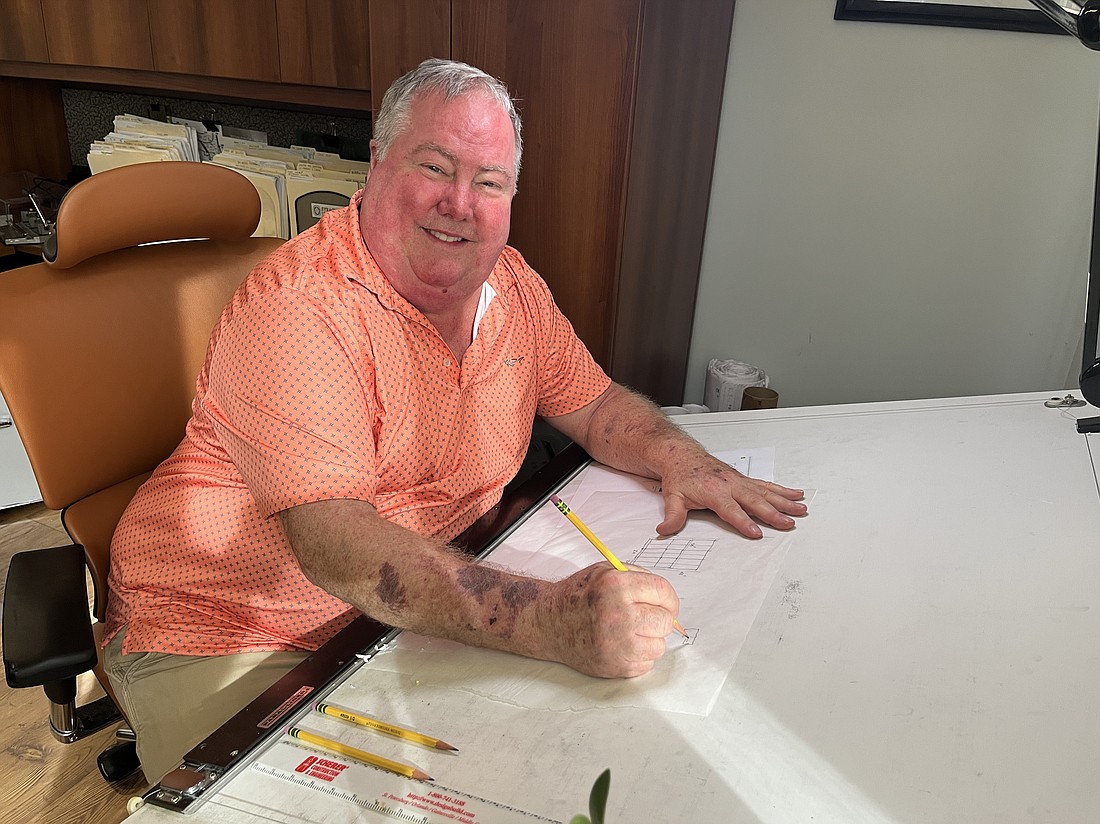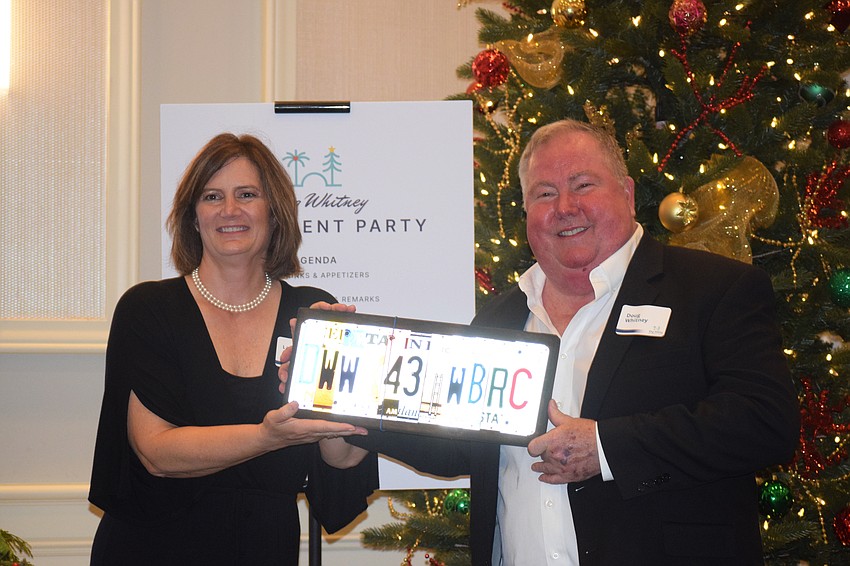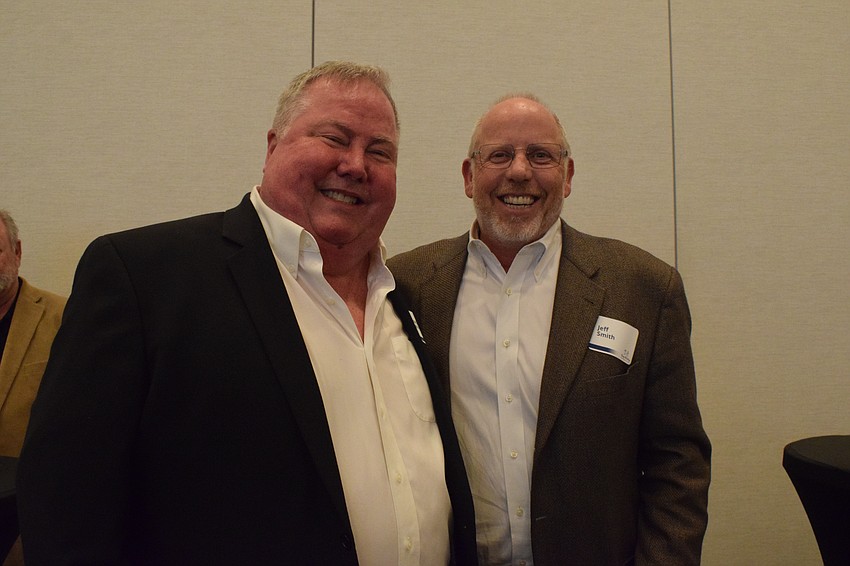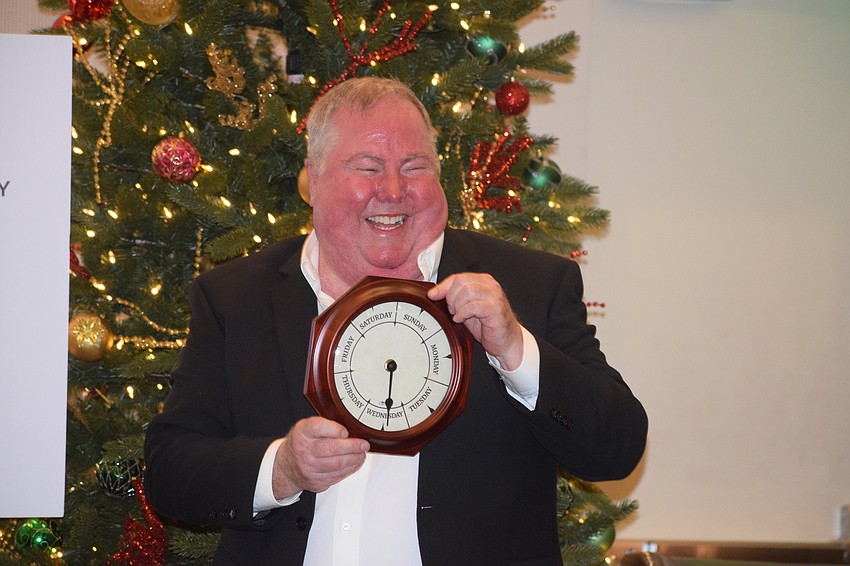- April 4, 2025
-
-
Loading

When River Club’s Douglas Whitney was in elementary school and finished all his classwork, his teachers would let him sit by the window and draw.
All he could see were buildings, so naturally he started drawing the buildings.
Whitney said it made him think about how the buildings go together and why the windows lined up.
It was his first introduction to architecture.
Since then, Whitney has spent his 43-year architecture career drawing by hand.
Whitney, who is an architect, chair emeritus and senior principal for WBRC, is the only architect in WBRC’s Lakewood Ranch office with a drafting table in the office.
“The key is having a nice, sharp No. 2 pencil and either a piece of white paper or tracing paper,” Whitney said. “The key to doing a landscape is first to draw the horizon and then you kind of figure out where your focal point is going to be.”
Whitney’s days of hand drawing designs for WRBC are numbered as he retires Jan. 1.
“Retirement was never really a goal of mine, but I’m just getting to that point in time,” he said. “I’ll be 67 in January. It would be nice to have time to do some things for myself. I’m looking forward to moving onto the next chapter and giving other people behind me a chance to move up.”
Over the years, Whitney has appreciated architects’ talent of visualizing designs in three dimensions. He said computers have made it easier for architects to share their visions for projects with clients.
“One of my favorite sayings is, ‘I can see the future because I can see what the building is going to look like, but I still have trouble reading minds,’” Whitney said with a laugh. “Seeing into the future is one of the things I can do.”

His life in architecture hasn’t always been easy.
Whitney recalled being in his first year of architecture school at Syracuse University in 1975 and being tasked with creating a drawing by hand. He said everyone in the class posted their drawings on the wall, admiring their hard and creative work.
The professor was not impressed in his work.
“He went around and he said, ‘This one is crap,’ and pulled it off and threw it on the floor,” he said.
His professor continued criticizing each piece and throwing it to the floor. He then told the class, “Sit down and I’ll teach you how to draw,” Whitney said.
Whitney said that first class was eye opening.
“I didn’t realize how bad it was until I learned how to do the proper line weights and how to make things stand out,” he said. “You don’t necessarily appreciate architectural drawing compared to just sketching. Architectural drawings are a whole different thing.”
In his first year with WBRC in 1980, Whitney’s first project was converting an old, three-story brick shoe factory into senior living apartments in Old Town, Maine. He visited the building, drew the front elevation of the design by hand and thought he did well. A coworker told him it was OK, but then redrew the entire project.
“He said it wasn’t anywhere near good enough to what he expected,” Whitney said. “I learned pretty quickly to pay more attention to the line weights and the drafting skills I thought I had but apparently didn’t yet. That’s one of the things about hand drawing that stands out. When you look at somebody else’s work, you can tell if they’re good at it when they draw by hand.”
Whitney spent years perfecting his drawings and has designed more than 150 post offices, more than 22 school and university projects, 15 assisted living and memory care projects, and hundreds of retail stores and restaurant projects.
His career has given him the opportunity to design projects in 23 states.
In 2001, Whitney realized he didn’t want to wait until his retirement to move to Florida. He already had spent 30 years of winters in Florida visiting his parents, Jan and Wil Whitney, and saw how much they enjoyed life in the Sunshine State. He was able to convince WBRC to open an office in Lakewood Ranch in 2002.
Whitney served as the president of WBRC from 2013 to 2022 when he became the board’s chair emeritus.
His favorite project in Lakewood Ranch was R.E. Crawford Construction’s headquarters in Lakewood Ranch Corporate Park. He had to think creatively to give the building character.
Whitney grabbed sticky notes and a sharp No. 2 pencil to explain how the building undulated.

Jeff Smith, the president and CEO of R.E. Crawford Construction, met Whitney in 2002 when WBRC was located in the executive suits of Keiser College just around the corner from Smith’s offices.
Smith and Whitney began working with each other, with their first project being a Best Buy in St. Petersburg.
From working on a Verizon Wireless store together to million dollar projects, Smith always has appreciated Whitney’s positive demeanor and level headedness. In meetings with clients, Smith said Whitney always was “spot on” with his answers and vision.
When it came time to design the construction company’s headquarters, Smith knew Whitney was the man for the job. He gave him free reign on the design.
“Everything he drew was spot on,” Smith said of the design. “He sketched it up on a little piece of paper with a pen, and it was exactly what we wanted with just a couple tweaks.”
Whitney also was charged with designing the Tidewell Hospice House in Lakewood Ranch. It was one of the first hospice facilities designed specifically as an inpatient hospice house, he said.
The hospice house needed to be brought up to current medical codes to run more like a hospital that is noncombustible and has all the same safety features as a regular hospital.
WBRC now is the go-to firm to design other hospice houses in the state, including the new hospice house in New Port Richey that broke ground Dec. 8, Whitney said.
A project Whitney will always treasure is Suzanne Smith Elementary School in Levant, Maine. He based the design off a traditional farmhouse style, which includes a big house, little house, back house and barn. He included a silo, which houses a reading area as part of the library.
“I knew it was going to end up being one of the biggest buildings in the whole town,” he said. “I was trying to figure out a way to make it look like it didn’t just fall out of the sky like the ‘Wizard of Oz.’”
Whitney said his farmhouse style design was not an easy sell. He said a school board member told him she wasn’t going to send her children to school in a “chicken house.” But after she saw the model Whitney built by hand out of cardboard, she came around to the idea.
After the school was constructed, a survey was conducted amongst teachers and administrators about which schools were their favorite in the state, Whitney said. His school was voted the favorite, which he said is gratifying.
Whitney is not the type of person to point to a building and say he had a hand in its creation. He’s quiet and humble, Laura Adcock, a WBRC principal, said.
Adcock has learned how to identify a Whitney-designed building by some of his signature features, such as Palladian windows, which consists of a semi-circular arch above two rectangular window casings. He also likes to place a white brick surrounded by red bricks in his brick designs, she said.
Adcock has worked with Whitney since she was working for R.E. Crawford Construction and was in need of an architect to serve as a mentor. Everyone told her Whitney was her guy.
They’ve worked together for 20 years.
She said the only time Whitney ever stopped her in her tracks was when she kept calling concrete cement. Although cement becomes concrete when it’s dry, she kept calling it cement.
“He goes, ‘OK, we’re going to nip this in the bud because you sound like Elly May Clampett (from ‘The Beverly Hillbillies’),’ Adcock said laughing.
Adcock has not only worked professionally with Whitney, but he’s become like family to her. Together, they’ve had family dinners, celebrated holidays, played in baseball games and attended concerts.
She’ll never forget the Celine Dion concert they attended together in Tampa. She always wanted to see Dion in concert in Las Vegas, but when Whitney saw she was coming to Tampa, they immediately bought tickets. It was a dream come true, she said.
“Mark Twain said, ‘If you find a job you love…’ — and I add, ‘the people you love doing it with’ — ‘you never work a day in your life,‘ Adcock said. “That’s what it’s been for me, and I hope it’s been that for him.”

Although he’s spent his career designing for other people, Whitney has yet to have the chance to design a home for himself. Retirement will be the perfect time for him to focus on the property in Maine he bought to make it his dream home.
The home is on a lake and at the end of a 2-mile dirt road. All he’ll be able to see is the lake, mountains, birds and trees, which he said makes it a “fabulous location” for him to double the size of the three-bedroom cabin already on the property.
He’s already started developing new hobbies to fill his days of retirement such as learning to play the violin. He stopped playing when he was 12 years old because he was already involved in several other activities. He said it’s been fun using online tutorials to teach himself.
Whitney already is mastering “Silent Night” and “Jingle Bells” in time for the holidays.